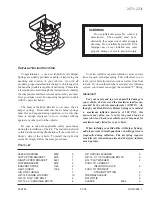
Tires and wheels
261
Underinflated tires can
R
cause excessive and uneven tire wear
R
adversely affect fuel economy
R
lead to tire failure from being overheated
R
adversely affect handling characteristics
Overinflated tires
G
Warning!
Follow recommended tire inflation
pressures.
Do not overinflate tires. Overinflated tires
can adversely affect handling and ride
comfort, wear unevenly, increase stopping
distance, and result in sudden deflation
(blowout) because they are more likely to
become punctured or damaged by road
debris, potholes etc.
Overinflated tires can
R
adversely affect handling characteristics
R
cause uneven tire wear
R
be more prone to damage from road
hazards
R
adversely affect ride comfort
R
increase stopping distance
Checking tire inflation pressure
Safety notes
G
Warning!
Follow recommended tire inflation
pressures.
Do not underinflate tires. Underinflated
tires wear excessively and/or unevenly,
adversely affect handling and fuel
economy, and are more likely to fail from
being overheated.
Do not overinflate tires. Overinflated tires
can adversely affect handling and ride
comfort, wear unevenly, increase stopping
distance, and result in sudden deflation
(blowout) because they are more likely to
become punctured or damaged by road
debris, potholes etc.
Do not overload the tires by exceeding the
specified load limit as indicated on the Tire
and Loading Information placard on the
driver’s door B-pillar. Overloading the tires
can overheat them, possibly causing a
blowout. Overloading the tires can also
result in handling or steering problems, or
brake failure.
Check the tire inflation pressure at least every
other week.
Check and adjust the tire inflation pressure
when the tires are cold. The tires can be
considered cold if the vehicle has been
parked for at least 3 hours or driven less than
1 mile (1.6 km).
If you check the tire inflation pressure when
the tires are warm (the vehicle has been
driven for several miles or sitting less than
3 hours), the reading will be approximately
4 psi (0.3 bar) higher than the cold reading.
This is normal. Do not let air out to match the
specified cold tire inflation pressure.
Otherwise, the tire will be underinflated.
Checking tire inflation pressure
manually
Follow the steps below to achieve correct tire
inflation pressure:
X
Remove the cap from the valve on one tire.
X
Firmly press a tire gauge onto the valve.
X
Read the tire inflation pressure on the tire
gauge and check against the
recommended tire inflation pressure on the
Tire and Loading Information placard on the
driver’s door B-pillar (
Y
page 255). If
necessary, add air to achieve the
recommended tire inflation pressure.
Operation
Z
Содержание 2009 R-Class
Страница 1: ...R Class Operator s Manual ...
Страница 28: ...Exterior view 26 Exterior view At a glance ...
Страница 30: ...Cockpit 28 Cockpit At a glance ...
Страница 32: ...Instrument cluster 30 Instrument cluster At a glance ...
Страница 34: ...Instrument cluster 32 At a glance ...
Страница 36: ...Storage compartments 34 Storage compartments At a glance ...
Страница 44: ...42 ...
Страница 84: ...82 ...
Страница 149: ...Control system 147 Menus and submenus Controls in detail Z ...
Страница 188: ...3 zone automatic climate control 186 3 zone automatic climate control Control panels USA only Controls in detail ...
Страница 244: ...242 ...
Страница 300: ...298 ...
Страница 390: ...388 ...
Страница 401: ...Weights 399 Weights Model All models Roof load max 220 lb 100 kg Technical data Z ...
Страница 410: ...408 ...
Страница 412: ...Order no 6515 1823 13 Part no 251 584 08 82 Edition A 2009 É2515840882 ËÍ 2515840882 ...
















































